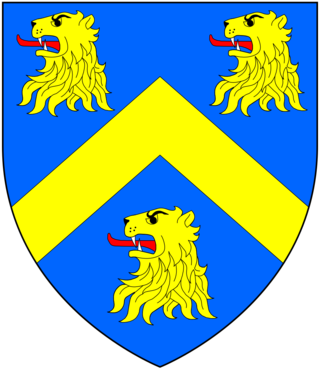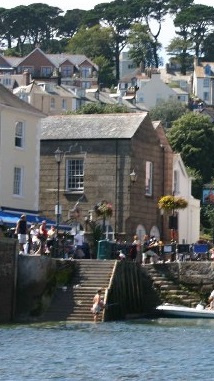
Bridgwater is a historic market town and civil parish in Somerset, England. The town had a population of 41,276 at the 2021 Census. Bridgwater is at the edge of the Somerset Levels, in level and well-wooded country. The town lies along both sides of the River Parrett; it has been a major inland port and trading centre since the industrial revolution. Most of its industrial bases still stand today. Its larger neighbour, Taunton, is linked to Bridgwater via a canal, the M5 motorway and the GWR railway line.

Marquess of Anglesey is a title in the Peerage of the United Kingdom. It was created in 1815 for Henry Paget, 2nd Earl of Uxbridge, a hero of the Battle of Waterloo, second in command to the Duke of Wellington. The Marquess holds the subsidiary titles of Earl of Uxbridge, in the County of Middlesex, in the Peerage of Great Britain (1784), Baron Paget, de Beaudesert, in the Peerage of England (1553), and is also an Irish Baronet, of Plas Newydd in the County of Anglesey and of Mount Bagenall in the County of Louth.

Dulverton is a small town and civil parish in west Somerset, England, near the border with Devon. The town had a population of 1,408 at the 2011 Census. The parish includes the hamlets of Battleton and Ashwick which is located approximately 3.5 miles (5.6 km) north west of Dulverton. To the west of the hamlet lies Ashwick House, built in the Edwardian style in 1901. Also nearby is the estate of Northmoor, formerly a seat of Sir Frederick Wills, 1st Baronet of Northmoor, one of the four Wills Baronetcys, and the founders of the Imperial Tobacco Company. In 1929 Sir Frederick's son & heir, Sir Gilbert Wills, 2nd Baronet, was raised to the peerage as Baron Dulverton, whose principal seat was at Batsford Park, near Batsford, Gloucestershire.

Somerton and Frome is a constituency in Somerset represented in the House of Commons of the UK Parliament since 2023 by Sarah Dyke.

Milborne Port is a village, electoral ward and civil parish in Somerset, England, east of Sherborne, and in the South Somerset district. It has a population of 2,802. The parish includes the hamlets of Milborne Wick and Kingsbury Regis.
Milborne Port is a former parliamentary borough located in Somerset. It elected two members to the unreformed House of Commons between 1298 and 1307 and again from 1628, but was disenfranchised in the Reform Act 1832 as a rotten borough.

Wookey is a village and civil parish 2 miles (3.2 km) west of Wells, on the River Axe in the Mendip district of Somerset, England. The parish includes the village of Henton and the nearby hamlets of Yarley and Bleadney where the River Axe travels the length of the village. There used to be a port at Bleadney on the river in the 8th century which allowed goods to be brought to within 3 miles (5 km) of Wells. Wookey is often confused with its sister village Wookey Hole, site of the Wookey Hole Caves.

There have been three Wyndham Baronetcies, all created in the Baronetage of England. All were created for descendants of Sir John Wyndham (d.1573) of Orchard Wyndham in the parish of Watchet, Somerset, by his wife Elizabeth Sydenham, daughter and co-heiress of Sir John Sydenham of Orchard Sydenham. He was a grandson of Sir John Wyndham of Felbrigg, Norfolk, by his first wife Lady Margaret Howard, the fourth daughter of John Howard, 1st Duke of Norfolk.

The Medlycott Baronetcy, of Ven House in the County of Somerset, was a title in the Baronetage of the United Kingdom. It was created on 3 October 1808 for William Medlycott, Member of Parliament for Milborne Port from 1790 to 1791. The family descended from James Medlycott, of Ven House, who represented Milborne Port in the House of Commons between 1710 and 1722. His son Thomas Medlycott died without surviving male issue in 1763 and left his estates to his maternal nephew Thomas Hutchings, who adopted the surname of Medlycott. His son was the first Baronet. The baronetcy became extinct with the death of the 9th Baronet in 2021.

The Church of St John the Evangelist in Milborne Port, Somerset, England is a cruciform church of late Anglo-Saxon date and parts may well span the Norman conquest. The church has been designated by English Heritage as a Grade I listed building.

Ven House in Milborne Port, Somerset, England is an English manor house that has been designated as a Grade I listed building.
The Hundred of Horethorne is one of the 40 historical Hundreds in the historic county of Somerset, England, dating from before the Norman conquest during the Anglo-Saxon era although exact dates are unknown. Each hundred had a 'fyrd', which acted as the local defence force and a court which was responsible for the maintenance of the frankpledge system. They also formed a unit for the collection of taxes. The role of the hundred court was described in the Dooms (laws) of King Edgar. The name of the hundred was normally that of its meeting-place.

The Old Town Hall, Richmond on Whittaker Avenue in Richmond, London is a former municipal building which from 1893 to 1965 served as the town hall for the Municipal Borough of Richmond.

Milborne Wick Mission Church is a Church of England church in Milborne Wick, Somerset, England. The church was built in 1891 and is a Grade II listed building. It now holds two services a month and has accommodation for 30 people.

Wells Town Hall is a municipal building in the Market Place in Wells, Somerset, England. The building, which is the headquarters of Wells City Council, is a Grade II listed building.

Bridgwater Town Hall is a municipal building in the High Street, Bridgwater, Somerset, England. The town hall, which was the headquarters of Bridgwater Borough Council, is a Grade II listed building.

Crewkerne Town Hall is a municipal building in the Market Square in Crewkerne, Somerset, England. The building, which is the meeting place of Crewkerne Town Council, is a Grade II listed building.
Thomas Medlycott was one of the two members of Parliament for Milborne Port from 1734 to 1742 and 1747 to 1763. There is no record of him having spoken in Parliament.

Ilchester Town Hall is a municipal building in the High Street in Ilchester, Somerset, England. The structure, which serves as the offices and meeting place of Ilchester Town Council, is a Grade II listed building.

Fowey Town Hall is a municipal building on the Town Quay in Fowey, Cornwall, England. The structure, which serves as meeting place of Fowey Town Council, is a Grade II listed building.


















